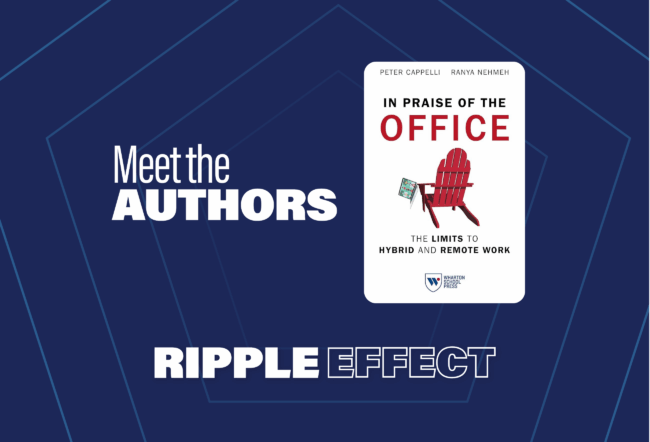New York Times bestselling author Daniel Pink joins the show to talk about navigating the changing landscape of professional work.
Transcript
Dan Loney: It’s always great to be joined by New York Times bestselling author Daniel Pink, who has written numerous books and researched so much in this arena. Daniel, thanks for your time again.
When you hear the terms personal growth and career development, what do you think about and how do you view them in the landscape we’re in right now?
Daniel Pink: I actually don’t love those terms. Not to be the cranky old man on the porch right now, but I don’t love those terms because I don’t think most of think about it in that way. What we talk about is, how do I lead a good life? How do I do work that matters? How do I get important things done? To me, that’s the way that people actually talk about these kinds of things. When we make it a little too abstract, we often don’t come up with great solutions. And when we make it a little bit more concrete, we can come up with better, practical solutions.
Loney: That element of what we want from life seemingly has become more important in the last few years.
Pink: Huge. I’ve written a lot of books, and they’re nominally books about business, economics, and so forth. But as I get into every book, every single book comes back to meaning. People are looking for meaning in their life. Why am I here? What am I doing? How do I spend my days? I think that those questions sit at the border of personal growth and career development because we spend over half of our waking hours at work. So, if you want to have a good life, you can’t say, “Oh, there’s over half of my waking hours that I don’t care about.” You want some integration between those two things.
Loney: Which is interesting because I think a lot of what we when through during the pandemic was thinking more about our lives. We just didn’t’ want to be that person working 9 to 5, 8 to 4. We were even willing to work 10, 12 hours a day broken up, with a little bit of our personal life in the middle.
Pink: That is exactly right, too. If you think about people searching for meaning, you have to think about who human beings are. To me, I think that it’s human nature to be autonomous and self-directed. That’s who we are as human beings. It can get beaten out of us very easily.
What we want is a chance to chart our own way, to operate under our own steam, to do things the way we want to do it. People are responsible. People want to be accountable. What they don’t want to be is controlled. The big problem in workplaces is control, because when managers or organizations try to control people – when any human being tries to control another human being – there are only two responses. The person complies, or they defy. We don’t want to be compliant totally at work, and we don’t want to be defiant. We want to be engaged. And the way we engage is exactly what you’re talking about. Tell me what my objectives are, tell me what the point of the exercise is, give me the tools to do my job, and let me do it – and I’ll do a great job.
Loney: How has that changed how companies and managers think about the relationship between the two, because it feels like it’s been flipped on it’s head a little bit?
Pink: I think the change is slow, and you sort of see this in the return-to-work mandates that are happening right now at large companies. Again, I started writing about remote work 20-plus years ago, and people thought I was nuts and saying that will never work, you can’t trust people to do it. Then, as you mentioned, in the pandemic, we had several hundred million people figure it out in four days and do it for two years. It’s a pretty good proof of concept, so it become a difficult egg to unscramble. I find that a lot of managers, a lot of leaders have been surprised by people’s resistance to these return-to-office mandates, and it’s because people have proved that you can be autonomous and be accountable at the same time. In my view, where we’re headed right now it these battles is what will essentially become permanent hybrid.
Loney: What was the conversation like 20 years ago when you brought up the idea of remote work?
Pink: It was two-pronged, underneath the main heading of, “You’re crazy.” The first prong was technological. We don’t have the technology to make that happen. I think that argument is completely gone. The other one is, we can’t trust people to do that. Because if you let people work at home, if you let people work remotely, if you can’t see them, then they’re going to shirk. And that’s fundamentally not true. I think it’s true for some people, but that’s a hiring problem. That’s not a work organization problem. And believe me, if you walk through companies or organizations of any kind in North America, you’re going to see some people who are less than diligent.
Loney: What do you think the remote work scenario is going to look like long term.
Pink: We will move to what is essentially hybrid as the norm. And we have to sort out some pretty fundamental questions which we haven’t sorted out. Things like, what kind of work should we do together? What kind of work should we do separately? We don’t have a good answer to that. What kind of work should be synchronously and asynchronously? We don’t have a good answer to that. I think we do too much synchronously. If we have people working certain days in the office and certain days at home, what does an office look like? I don’t think it looks like rows of cubicles anymore. What’s the role of a manager when she can’t see everybody? There are some tough questions. I think we’ll get to the point where it’s hybrid, but we no longer call it hybrid. We just call it work.
Loney: The loss of the water-cooler conversation alone is going to damage the office, right?
Pink: You know what? Here’s the thing: I actually like water-cooler conversations. I think there’s something valuable in them. This is why I don’t think it’s going to be all-in-one. What we have to do is figure out what’s the purpose here. When you’re working remotely, you can do a lot of really good head-down work that doesn’t involve other people. When you’re with other people, you should be doing things that are collaborative. We’re not thinking in terms of the intention of what people are doing. We’re just moving to the second step too quickly. The first step should be, what are people doing and how can we help them do it. Again, I really think we’re going to get there so that we don’t call it hybrid anymore.
I’ll give you an analogy. The most important conversation I have in my household every day with my wife occurs around 6 o’clock, which is what are we going to have for dinner? Sometimes she cooks, sometimes I cook, sometimes we walk down the street to Taco Bamba, sometimes we order in. It’s hybrid eating, right? We figure it out based on our needs at that moment, and I think that’s where the workplace is going to go.
Loney: You also have to throw in that component of what does that mean for the success of people’s careers and their lives, moving forward?
Pink: This is why I don’t think that most places should be all remote, partly for those reasons. For the water-cooler reason and for the advancement reason. And for the learning. You learn things by being around other people. You learn things by doing great work on your own, you learn things by being around other people. What we need to do is really focus on the intention. What are we doing? And how can we put people in the best situations to do their very best.



